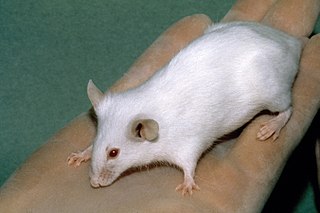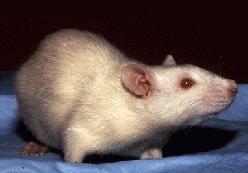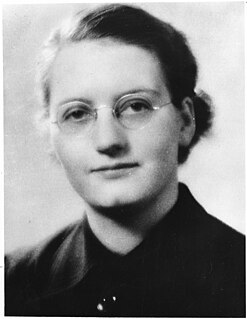Related Research Articles

A model organism is a non-human species that is extensively studied to understand particular biological phenomena, with the expectation that discoveries made in the model organism will provide insight into the workings of other organisms. Model organisms are widely used to research human disease when human experimentation would be unfeasible or unethical. This strategy is made possible by the common descent of all living organisms, and the conservation of metabolic and developmental pathways and genetic material over the course of evolution.

The laboratory mouse is a small mammal of the order Rodentia which is bred and used for scientific research. Laboratory mice are usually of the species Mus musculus. They are the most commonly used mammalian research model and are used for research in genetics, psychology, medicine and other scientific disciplines. Mice belong to the Euarchontoglires clade, which includes humans. This close relationship, the associated high homology with humans, their ease of maintenance and handling, and their high reproduction rate, make mice particularly suitable models for human-oriented research. The laboratory mouse genome has been sequenced and many mouse genes have human homologues.
Charles River Laboratories, Inc., is an American corporation specializing in a variety of preclinical and clinical laboratory services for the pharmaceutical, medical device and biotechnology industries. It also supplies assorted biomedical products and research and development outsourcing services for use in the pharmaceutical industry. According to its website, its customers include leading pharmaceutical, biotechnology, agrochemical, government, and academic organization around the globe.

A laboratory rat or lab rat is a rat of the species Rattus norvegicus domestica which is bred and kept for scientific research. While less commonly used for research than mice, rats have served as an important animal model for research in psychology and biomedical science.

The Jackson Laboratory is an independent, nonprofit biomedical research institution dedicated to contributing to a future of better health care based on the unique genetic makeup of each individual. With more than 2,100 employees in Bar Harbor, Maine; Sacramento, California; and at a new genomic medicine institute in Farmington, Connecticut; the Laboratory's mission is to discover precise genomic solutions for disease and empower the global biomedical community in the shared quest to improve human health. The institution is a National Cancer Institute-designated Cancer Center and has NIH centers of excellence in aging and systems genetics.
Texas Biomedical Research Institute, located in San Antonio, Texas, is an independent, non-profit biomedical research institution, specializing in genetics and in virology and immunology. Texas Biomed is funded by government and corporate grants and contracts, and donations from the public.
Murine coronavirus (M-CoV) is a species of virus in the family Coronaviridae, genus Betacoronavirus. Several genomes of the species are available from GenBank nucleotides.

The history of model organisms began with the idea that certain organisms can be studied and used to gain knowledge of other organisms or as a control (ideal) for other organisms of the same species. Model organisms offer standards that serve as the authorized basis for comparison of other organisms. Model organisms are made standard by limiting genetic variance, creating, hopefully, this broad applicability to other organisms.
Charles Joseph Epstein of Tiburon, California, was a geneticist who was severely injured in 1993 when he became a victim of a mail bomb attack by the Unabomber. He was a researcher at the University of California, San Francisco and the Buck Institute for Age Research.
Susan L. Ackerman is an American neuroscientist and geneticist. Her work has highlighted some of the genetic and biochemical factors that are involved in the development of the central nervous system and age-related neurodegeneration. Her research is aimed at helping scientists understand what causes several types of neurodegeneration in mammals. This research, and others' like it, may lead to cures for neurodegenerative diseases. Ackerman is a professor at University of California San Diego. She was formerly a professor at the Jackson Laboratory and the Sackler School of Graduate Biomedical Sciences at Tufts University. She also serves as an adjunct professor at the University of Maine, Orono. Ackerman was an associate geneticist at Massachusetts General Hospital in Boston, Massachusetts.

Elizabeth Shull Russell, also known as "Tibby" Russell, was an American biologist in the field of mammalian developmental genetics, spending most of her career at the Jackson Laboratory in Bar Harbor, Maine. Russell is most recognized for her ground breaking work in pigmentation, blood-forming cells, and germ cells. She also raised awareness of the benefits of genetically-defined laboratory animals in biomedical research.
Limb body wall complex (LBWC) is a rare fetal malformation of unknown origins.
Abbie E. C. Lathrop was a rodent fancier who bred fancy mice.
Mouse News Letter (MNL) was a bulletin of mouse genetics information published from 1949 to 1998. In 1990 Mouse News Letter changed its name to Mouse Genome which merged with the journal Mammalian Genome in 1998. Mouse News Letter now exists as a company, Mouse News Letter Ltd, which promotes the science of Genetics and provides funds to enable younger scientists to attend Genetics Conferences. “To survey the history of the Mouse News Letter is to see the history of mouse genetics unfold.” So wrote Mary F Lyon in 1997.
Mouse models have frequently been used to study Down syndrome due to the close similarity in the genomes of mice and humans, and the prevalence of mice usage in laboratory research.
Coisogenic strains are one type of inbred strain that differs by a mutation at a single locus and all of the other loci are identical. There are numerous ways to create an inbred strain and each of these strains are unique. Genetically engineered mice can be considered a coisogenic strain if the only difference between the engineered mouse and a wild-type mouse is a specific locus. Coisogenic strains can be used to investigate the gene function of a certain locus.
Uta Francke is a German-American physician-geneticist known for her accomplishments in mapping genes to specific chromosome locations and discovering the genes and underlying mutations responsible for Prader-Willi and Rett syndromes. Her work on detailed mapping of human chromosome laid the foundation of the Human Genome Project and discovery of many other rare genetic disorders. She is currently a professor of Genetics and Pediatrics Emerita at Stanford University. She has also served as a consultant to 23andMe Inc since 2007, and as a part-time employee from 2010-2013.
Douglas Leon Wahlsten is a Canadian neuroscientist, psychologist, and behavior geneticist. He is a professor emeritus of psychology at the University of Alberta. As of 2011, he was also a visiting professor at the University of North Carolina at Greensboro in North Carolina, United States. He is known for his laboratory research on the behavior of mice, and for his theoretical writings on a wide range of other topics. His laboratory research has included studies of the effects of different laboratory environments and experimenter characteristics on the results of mouse studies. He and his colleagues have also developed an altered form of the rotarod performance test involving wrapping sandpaper around the rod, to reduce the ability of mice to grip the rod and ride around on it. He has criticized some of his fellow behavior geneticists for trying to separate the effects of genes and the environment on human intelligence, an endeavor he considers futile. He also met and became friends with Leilani Muir, later helping to edit her autobiography, A Whisper Past. He was the president of the International Behavioural and Neural Genetics Society from 2000 to 2001.
Taosheng Huang is a physician-scientist with substantial academic achievements and professional experience in translational research, specifically, in human mitochondrial genetics. He is a full Professor and Director of the Molecular Diagnostic Laboratory in the Division of Human Genetics at Cincinnati Children’s Hospital Medical Center (CCHMC). Huang has published over 100 manuscripts in many impactful journals.
References
- ↑ "People: Jackson Lab Mouse Geneticist To Chair International Nomenclature Committee". The Scientist. 1990-10-15. Retrieved 2017-08-30.
- ↑ Dan Huerly, A Drug for Down Syndrome, July 29, 2011, New York Times
| This article about an American scientist is a stub. You can help Wikipedia by expanding it. |